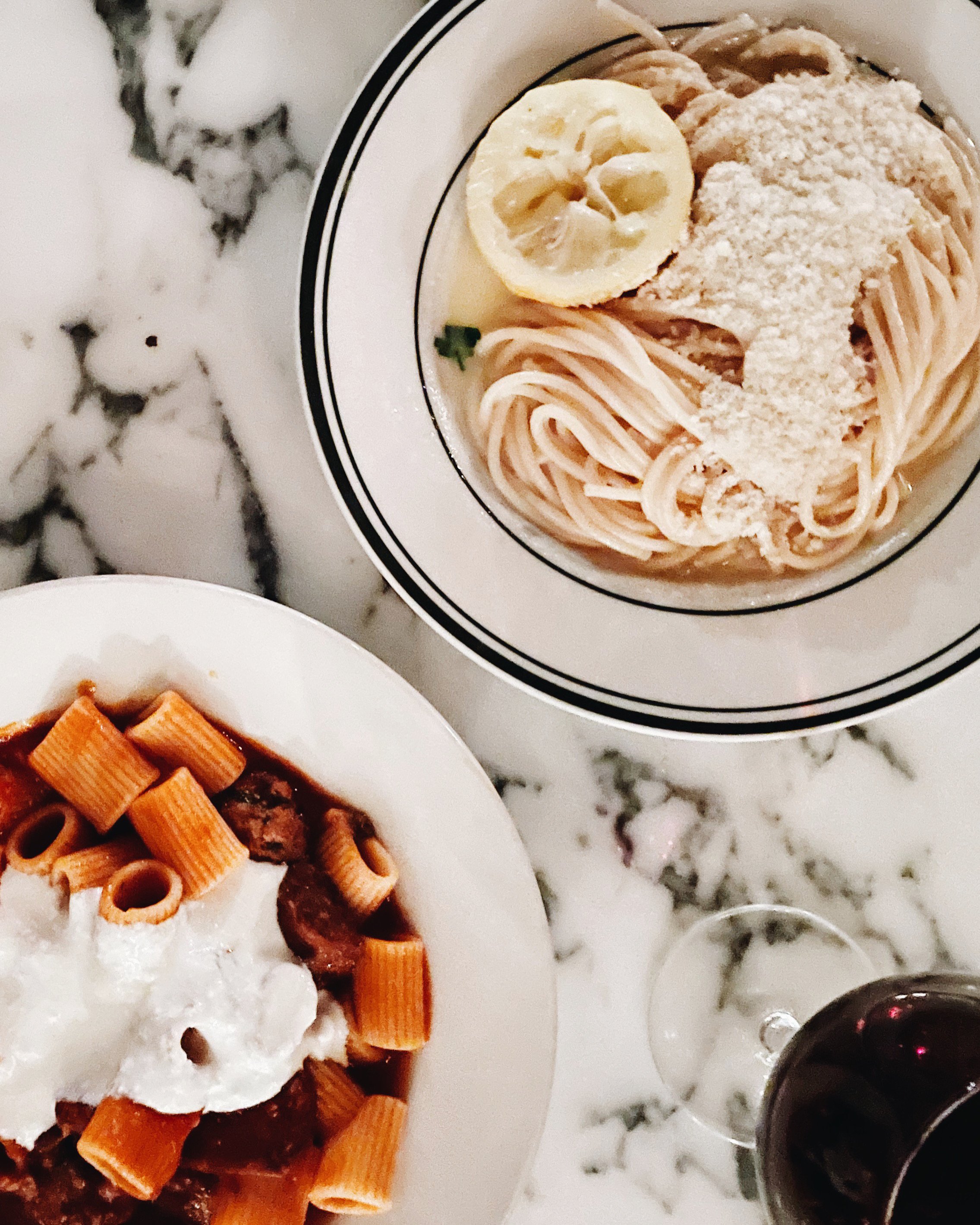enlightened spaghetti al limone
There are some dishes that just “belong” to certain places. Pasta al limone belongs to New York, where a close friend and I regularly split plates of it over high pours of house wine in dark, narrow, brick-walled restaurants whenever I come to visit. Before that, I’d never thought much about al limone other than the obvious—it’s pasta with lemon, now what?—but after having it at Lil Frankie’s in the Lower East Side in 2019, it’s permanently become The Other Dish, the complement, dish 2 of 2, any time the two of us order a red sauce as #1.
ragú and limone at gersi, bk
gersi bk, october 2021, ~10pm
Popular throughout Southern Italy and in New York City’s Italian America, pasta al limone has ambiguous origins often traced to Sorrento, the limoncello capital of the country—although I don’t especially remember al limone on any restaurant menus when I went. Yet despite definitive roots in the deeper Italian South, it operates very similarly to the Core Four Roman pastas (Carbonara, Cacio, Amatriciana, alla Gricia) in that it a) really works best with pecorino cheese and b) the less you do to it, the better it seems to turn out.
However, most recipes for it include a LOT of butter and a LOT of cream, kind of like fettuccine alfredo, and so limone at home was low on my list. But on a Friday night with a barren fridge I had no better ideas, so I wondered: what if the same trick I use to make fettuccine alfredo less of a trainwreck would work to enlighten al limone too, subbing out half the usual cream for a nearly equivalent amount of starchy pasta water?
It’s a simple enough enterprise even when exhausted. Spaghetti boils. You zest a lemon’s outsides, and juice the insides. Butter melts in another pan. Adding a small amount of cream seems like an instant mistake as the yellow butterfat floats defiantly in the white, but whisking it hard forces it to reconcile. No garlic. Some pepper. Definitely salt. And lots of pasta water, this sauce’s most essential ingredient: because yes, while it’s fortified with butter and a few tbsp. of cream per serving, the Roman method works most of this sauce’s magic, with pasta water and cheese creating the silky, clingy, yet refreshingly light-ish al limone sauce.
The one catch: serve it hot. Like, run-a-damp-towel-on-the-bowl-and-microwave-it-first hot. This sauce’s ingredients really want to pursue separate lives, and heat is absolutely essential to keeping them together long enough to finish your wine.
RECIPE
Classic pasta al limone achieves enlightenment. Though there’s still plenty of butter, pasta water stands in for part of the cream in this notoriously rich dish, using the cacio e pepe technique of emulsifying starchy water and pecorino cheese to create a silky, clingy, bright sauce that’s refreshingly lighter. Spaghetti is typical, but any strand pasta will work just fine.
Effortful time: 5 minutes
Total time: 20 minutes
Makes 2 bowls this size plus a little leftover for seconds
YOU NEED
12 oz. spaghetti or other long pasta
1 large lemon, zested and juiced
1/4 cup heavy whipping cream
4 tbsp. butter
1/3 cup grated pecorino romano cheese
Salt, to taste, I used about 1/4 tsp. to start (does not include salt for pasta water)
Freshly cracked black pepper
Additional pecorino, for serving
MAKE IT
Get prepped. Boil salty water, just enough to put your pasta in (this concentrates the starch, which is why this dish works—it’s easiest to do this using a skillet). Rinse your lemon very well, then zest it: I use a microplane grated lightly all over the lemon, stopping before hitting the bitter white inner rind. Cut off both ends, then cut the lemon in half—this creates a fancy garnish lemon—and wring out both halves over a glass. Keep these for the moment.
Cook your pasta for 2 minutes under the minimum al dente time on the package.
Halfway through, start your sauce. Whenever your pasta has 5 minutes left, use another skillet over low heat to melt the butter. Add the lemon zest and whisk to lightly cook it, 30 seconds. Then slowly pour in the cream and cook, whisking the entire time, until the sauce starts to bubble and thicken, about 2 minutes. Whisk in the lemon juice. Add the salt and crack in a few twirls of black pepper. Then add the cheese and continue whisking, another 1-2 minutes. Lower the heat to the lowest possible.
Transfer the pasta to the sauce. Don’t drain it—you want the pasta water that clings to the pasta during this step. Using tongs (it helps to scoot the pasta pot, which should now be off the heat, over to the sauce pan), move your pasta into your sauce. Use a cup or a ladle to scoop out some pasta water, and splash this into your pasta, tossing in between so that the sauce re-thickens before adding more. All in, I used about 1/4 of a cup.
Serve it up. Transfer to bowls (the warmer the better) and shower with more pecorino cheese and a few twirls of black pep. Garnish with the squeezed lemon halves.



